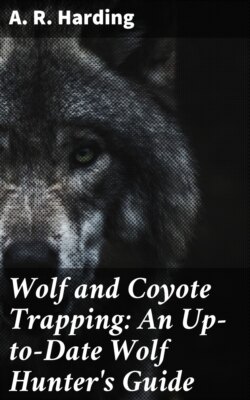Читать книгу Wolf and Coyote Trapping: An Up-to-Date Wolf Hunter's Guide - A. R. Harding - Страница 20
Difference in Sizes of Noes, Heel Pads and Canine Teeth of Wolves and Coyotes.
ОглавлениеKEY TO WOLF, COYOTE AND FOX PUPS.
Wolf Pups.
Muzzle blackish at birth, fading in a month or 6 weeks to greyish.
Head greyish in decided contrast to black of back, nose and ears.
Ears black at tips, fading to greyish in a month or 6 weeks.
Tail black, fading to grey with black tip.
Coyote Pups.
Muzzle tawny, or yellowish brown, becoming more yellowish with age.
Head yellowish grey, not strongly contrasted with rest of body.
Ears dark brown at tips and back, soon fading to yellowish brown.
Tail black, fading to grey with black tip.
Red Fox Pups.
Muzzle blackish.
Head dusky with side of face light yellowish.
Ears large, nearly the whole back of ears bright black at all ages.
Eyes and ears relatively larger and nose pad smaller than in coyote or wolf.
Tail dusky, tip white at all ages.
Grey Fox Pups.
Muzzle blackish.
Head greyish, face back or eyes sharply pepper and salt grey.
Ears large, back of ears dusky at tip, fulvous at base.
Eyes and nose pad small.
Tail with tip black at all ages.
Kit Fox Pups.
Muzzle with blackish patch on each side.
Head and face tawny or yellowish brown.
Ears tawny without black backs or tips.
Eyes larger and nose pad smaller than in young coyote.
Tail with tip black at all ages.
KEY TO YOUNG CATS, COONS AND BADGERS.
Young bobcats are much striped and spotted. Young cats of any kind can be distinguished by the short nose and round head.
Young coons have a broad black band across the face and eyes bordered above by a light band.
Young badgers have a white stripe between the eyes.
The bounty laws have always been a good thing for the trapper as they have helped much towards making his occupation a lucrative one, but, as before explained, it is doubtful if it has ever, in any marked degree, tended to decrease the numbers of predatory animals.
It is true that continued trapping will cause the numbers of wolves and coyotes to diminish, but would not the trapping be prosecuted practically the same, even if there were no bounties? We believe that it would, for if the bounty offered were any great incentive, there would be more trapping done during the summer when the furs were of no account.
Neither do we believe that it ever induces others, not trappers, to kill these animals, for they will kill them on every opportunity, bounty or no bounty. It is man's nature to kill, for he is the enemy of all animal life.
